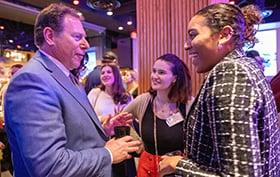How Top Schools Invest In Student Success
THIS GUIDE IS NO LONGER ACTIVE. For the current FP Guide, click here.
Penn State University, School of International Affairs
Crisis Simulations, Individualized Advising, and Course Customization Bolster Students

Last November, when the Penn State School of International Affairs (SIA) co-hosted its annual crisis simulation with the US Army War College, the challenge was formidable: Resolve territorial conflicts in the South China Sea. Over two days, SIA’s 50 first-year students played the role of delegates representing several countries — including China, Japan, and Vietnam — and engaged in intense negotiations to hammer out a peaceful agreement.
For 11 years, SIA has been participating in the event, which, according to the school’s director, Mitchell Smith, makes a lasting impression on students. It also, he adds, “encapsulates their educational experience — developing knowledge of a part of the world and the international system while thinking through how to apply a particular set of skills to challenges.”
But simulations, also conducted in individual classes, are just one aspect of SIA’s centerpiece, the Master of International Affairs program, which enables students to tailor concentrations to their interests via core courses and electives. SIA invests in its students on multiple fronts, ranging from hands-on instruction to individualized advising in what Smith calls “the cultivation of a globally engaged community among our student cohort.”

“We have a small faculty and student body, and many students do research with faculty, which often translates into internships and career choices.” –Mitchell Smith, Director, School of International Affairs, Penn State University
For example, students gather six times a year on a volunteer basis to participate in International Affairs Discussions, which are informal, hour-long conversations on timely topics chosen by student or faculty-member hosts. Smith, who created the activity, says, “I wanted it to be a free-flowing conversation where everyone felt like they could contribute as they wished.”
The student body is also diverse. The class of 2024 represented 13 countries, spoke 31 languages, and was 41 percent underrepresented. And at 50 to 60 students per class, the cohort allows for highly individualized advising, with each student assigned a professional and a faculty advisor. “We have a small faculty and student body, and many students do research with faculty, which often translates into internships and career choices,” Smith says.
Also benefiting from SIA’s study-abroad and hands-on experiences, SIA graduates find employment at a rate of 93 percent within a year, working for government agencies, nongovernmental organizations, and consulting and business firms. SIA’s aim, Smith says, is “to inculcate in students the skills needed to succeed in a career. Global problems are complex, changing, and interconnected, so it’s crucial to have an understanding of the world and a series of tools that involve teamwork, problem-solving, and advancing a set of objectives.”
Extensive Career Services and Alumni Connections Help Foster Success
SIA offers comprehensive career services, including professional development workshops, resume and cover letter review, job search assistance, and help identifying internships in the United States and abroad. It organizes career-exposure trips to Washington, DC, and New York City, and hosts on-campus job talks and panels.
SIA’s students tap into the powerful Penn State network, with 775,000-plus alums worldwide. The school connects students with SIA alums in multiple ways, including at networking receptions and through the school’s Alumni Mentorship Program.
Penn State University, School of International Affairs
https://www.sia.psu.edu
[email protected]
814-867-2242![]()
Contents
- How Top Schools Invest In Student Success
- George Washington University, Elliott School of International Affairs
- Rice University, School of Social Sciences
- Princeton University, Princeton School of Public and International Affairs
- Augusta University, Pamplin College of Arts, Humanities, and Social Sciences
- The Fletcher School at Tufts University
- Indiana University, Hamilton Lugar School of Global and International Studies
- Columbia University, School of International and Public Affairs
- Penn State University, School of International Affairs
- Texas A&M University, Bush School of Government & Public Service
- Georgetown University, School of Foreign Service
- University of Denver, Josef Korbel School of International Studies
- Yale University, Jackson School of Global Affairs
- George Mason University, Schar School of Policy and Government
- American University, School of International Service
- Seton Hall University, School of Diplomacy and International Relations
- Johns Hopkins University School of Advanced International Studies
